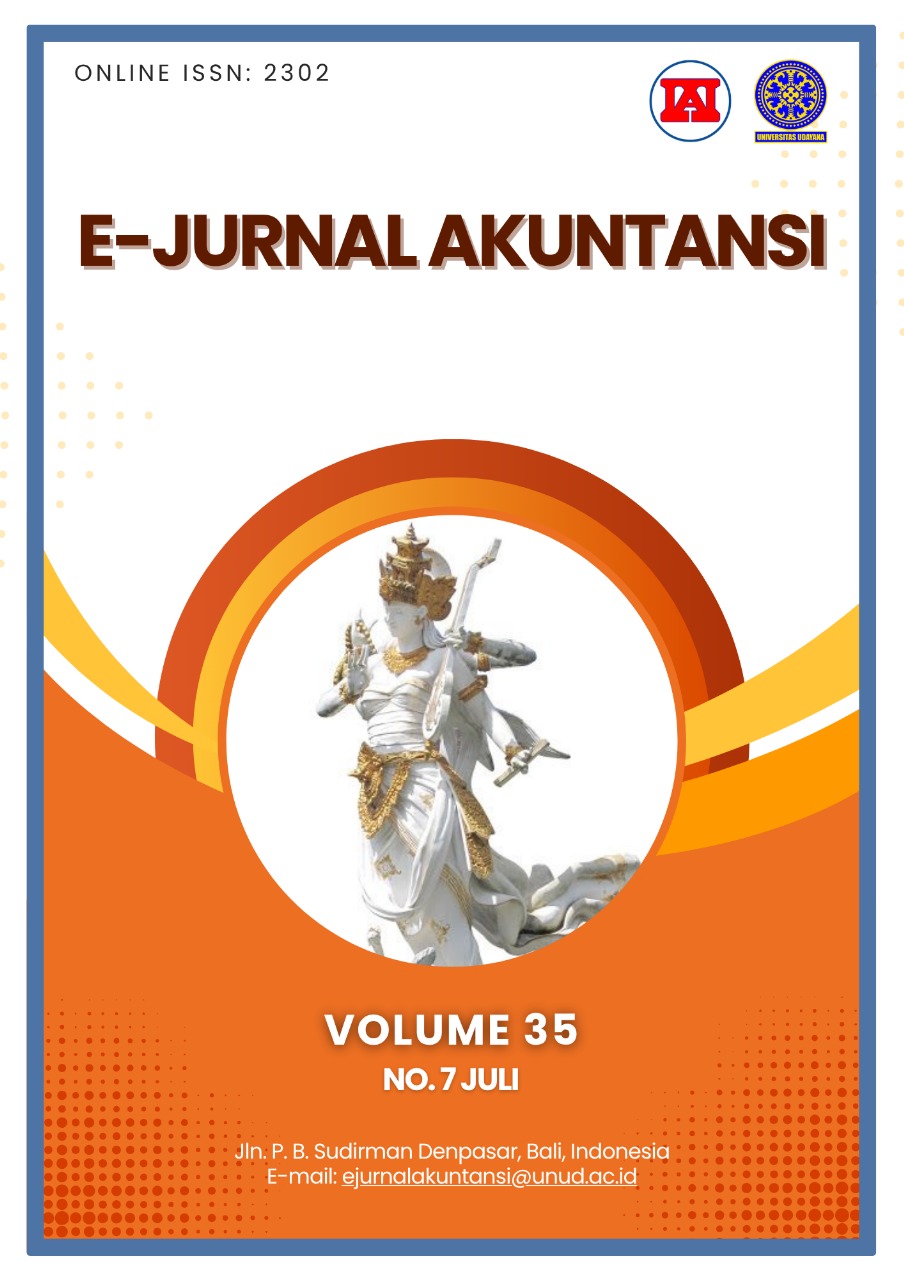Determinant Factors of Ecological Fiscal Transfer in Indonesia
Abstract
This research aims to identify the factors that determine the allocation of ecological fiscal transfer, including the size of local governments, biodiversity program diversity, and revenue sharing from natural resources. The sampling method employs purposive sampling and is analyzed using multiple regression analysis. The population of this research is the local government that plans and implements ecological fiscal transfers recorded in the DJPK of the Ministry of Finance in 2021-2023 with an analysis sample of 32 data that implement and plan ecological fiscal transfer. The findings of this study suggest that the size of local governments and revenue sharing from natural resources positively influence ecological fiscal transfer, while the diversity of biodiversity programs negatively impacts ecological fiscal transfer.
Keywords: Ecological Fiscal Transfer; Size of Local Government; Biodiversity; Natural Resource Revenue Sharing
Downloads
References
Busch, J., & Mukherjee, A. (2018). Encouraging State Governments to Protect and Restore Forests Using Ecological Fiscal Transfers: India’s Tax Revenue Distribution Reform. Conservation Letters, 11(2), 1–23. https://doi.org/10.1111/conl.12416
Canavire-bacarreza, G., Martinez-vazquez, J., Kebijakan, P., Internasional, P., Studi, S., & Andrew, K. (2019). Meneliti kembali faktor penentu desentralisasi fiskal : apa peran geografi ? 2016, 1–41. https://doi.org/10.1093/saya/lbw032
Coleman, james s. (1990). Foundations of Social Theory. In Cambridge: The Belknap Press of Harvard University Press, 1990, pp. xvi + 993. (Vol. 2, p. 294). https://doi.org/10.12681/sas.623
de Paulo, F. L. L., & Camões, P. J. S. (2020). An analysis of delay in implementing ecological fiscal transfers in Brazil. Environmental Development, 37(August), 100550. https://doi.org/10.1016/j.envdev.2020.100550
DJPK. (2022). Daftar Alokasi Dana Transfer Ke Daerah Dan Dana Desa Tahun Anggaran 2022. https://djpk.kemenkeu.go.id/?portfolio=daftar-alokasi-tkdd-2022-prov-aceh
Droste, N., Lima, G. R., May, P. H., & Ring, I. (2017). Municipal Responses to Ecological Fiscal Transfers in Brazil: A microeconometric panel data approach. Environmental Policy and Governance, 27(4), 378–393. https://doi.org/10.1002/eet.1760
Eisenack, K. (2024). Why Local Governments Set Climate Targets: Effects of City Size and Political Costs. In Environmental and Resource Economics (Vol. 87, Issue 11). Springer Netherlands. https://doi.org/10.1007/s10640-024-00919-1
Gu, Z., Tian, C., Zheng, Z., & Zhang, S. (2022). Favorable Fiscal Self-Sufficiency Enables Local Governments to Better Improve the Environmental Governance—Evidence from China’s Lower-Pollution Areas. Sustainability (Switzerland), 14(23). https://doi.org/10.3390/su142316202
Hariyati, I., Prasetyono, & Tarjo. (2020). Problematics of The Implementation of Green Budgeting in Local Governments. International Colloquium on Forensics Accounting and Governance (ICFAG), 1(1), 220–233.
Herlambang, D. (2025). 2023 Berpotensi Menjadi Tahun Terpanas, Mitigasi Perubahan Iklim Harus Dimasifkan. BMKG. https://www.bmkg.go.id/berita/utama/tahun-2023-berpotensi-menjadi-tahun-terpanas-mitigasi-perubahan-iklim-harus-dimasifkan
Iqbal, M. (2022). 10+ Penyebab Kebakaran Hutan di Indonesia. Lindungi Hutan. https://lindungihutan.com/blog/10-penyebab-kebakaran-hutan-di-indonesia/
Kementrian Keuangan. (2023). Anggaran Pendapatan Dan Belanja Negara. Kemenkeu. Informasi-APBN-Tahun-Anggaran-2024[1].pdf
Kusbandiyah, A., Fakhruddin, I., Pratama, B. C., & Setyono, D. (2022). Differences In Tax Avoidance Behavior Before And During Covid 19 In Non Cyclical Customer Companies On The Indonesia Stock Exchange. 3–6. https://doi.org/10.4108/eai.10-8-2022.2320795
Manurung, T. (2019). Skema Pembiayaan Konservasi dan Pelestarian Hutan Melalui Model Transfer Fiskal berbasis Ekologis di Indonesia. Auriga.or.Id, September, 1–43. https://auriga.or.id/related/getFilePdf/en/related/41/skema_pembiayaan_konservasi_dan_pelestarian_hutan_melalui_model_transfer_fiskal_berbasis_ekologis_di_indonesia_en.pdf
Matatula, J. (2024). Ekologi Perairan. In Asrul (Ed.), Insight Mediatama.
Mumbunan, S., Ring, I., & Lenk, T. (2012). Ecological fiscal transfers at the provincial level in Indonesia. UFZ Discussion Papers, 6. https://doi.org/10.1111/j.1548-1433.2010.01225.x
Olivia, D. (2020). Kerangka Penyelenggaraan Desentralisasi. 1(2), 85–93.
PDSI, Pusdantinkom, & BNPB. (2024). Statistik Bencana, Korban dan Kerusakan Menurut Jenis. Data Informasi Dan Bencana Alam. https://dibi.bnpb.go.id/statistik_menurut_bencana
Pramono, H., Fakhruddin, I., & Hapsari, I. (2022). Pengaruh Corporate Social Responsibility dan Kinerja Keuangan Terhadap Nilai Perusahaan. Ratio : Reviu Akuntansi Kontemporer Indonesia, 3(2), 78. https://doi.org/10.30595/ratio.v3i2.13751
Samborska, V., & Hannah, R. (2024). Wildfires. Ourworldindata. https://ourworldindata-org.translate.goog/wildfires?_x_tr_sl=en&_x_tr_tl=id&_x_tr_hl=id&_x_tr_pto=tc
Saputra, W., Halimatussadiah, A., Haryanto, J. T., Moeis, F. R., Nurfatriani, F., & Salminah, M. (2021). Designing Ecological Fiscal Transfer Policy Using the Regional Incentive Fund (DID), Specific Allocation Fund (DAK), and Village Fund (DD) to Realize Sustainable Forest Governance in Indonesia. XV World Forestry Congress, 1–9.
Sipongi. (2024). Indikasi Luas Kebakaran. Kementrian Lingkungan Hidup Dan Kehutanan. https://sipongi.menlhk.go.id/indikasi-luas-kebakaran
Soeprobowati, T. R., Saraswati, T. R., & Jumari. (2020). Biodiversity as a tool for environmental assessment. AIP Conference Proceedings, 2231(February). https://doi.org/10.1063/5.0002508

This work is licensed under a Creative Commons Attribution-ShareAlike 4.0 International License.

















